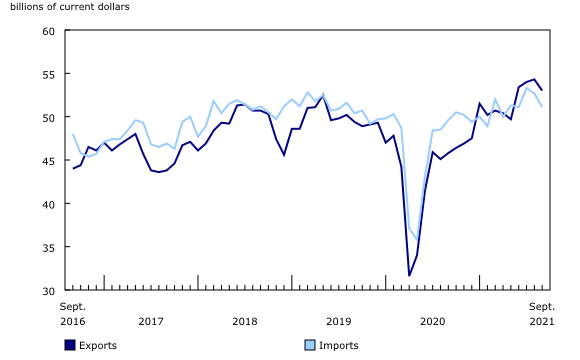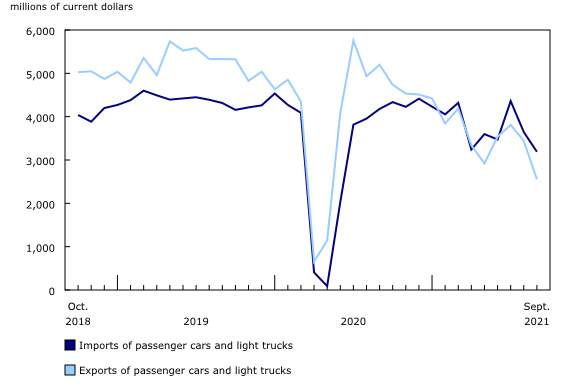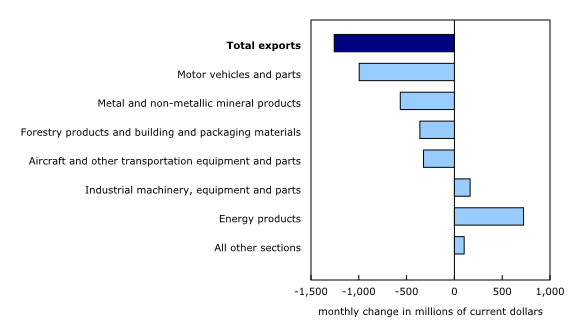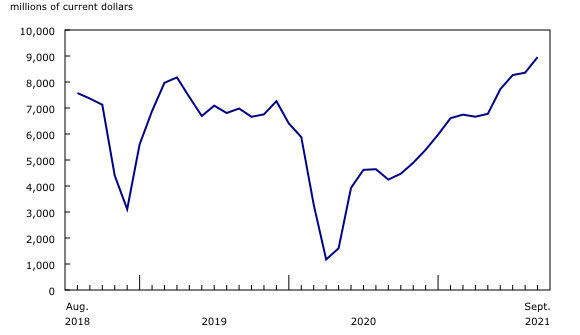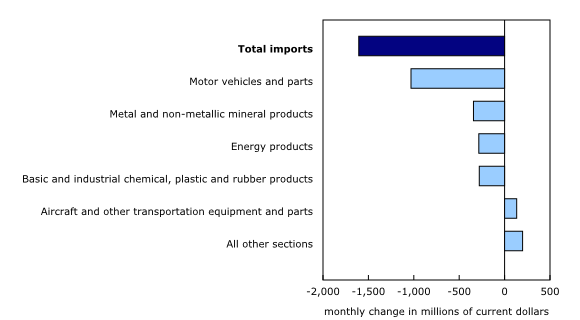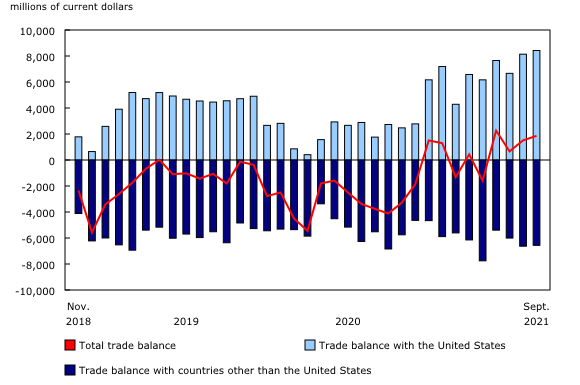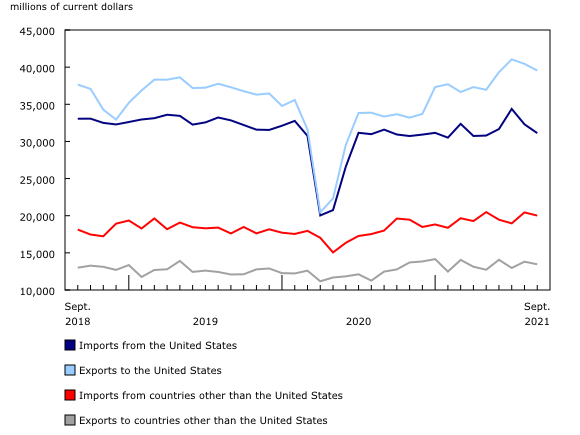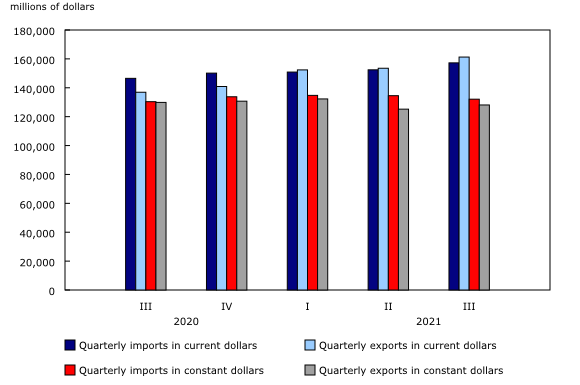Canadian international merchandise trade, September 2021
Archived Content
Information identified as archived is provided for reference, research or recordkeeping purposes. It is not subject to the Government of Canada Web Standards and has not been altered or updated since it was archived. Please "contact us" to request a format other than those available.
Released: 2021-11-04
Canada's merchandise exports decreased 2.3% in September, while imports were down 3.0%. Both declines were largely due to the shortage of semiconductor chips and their impact on the production of motor vehicles in North America.
Canada's merchandise trade surplus widened from $1.5 billion in August to $1.9 billion in September, a fourth consecutive monthly surplus. It is also the seventh monthly surplus recorded so far in 2021.
Consult the "International trade monthly interactive dashboard" to explore the most recent results of Canada's international trade in an interactive format.
The Canadian International Merchandise Trade Web Application is here
Last month, Statistics Canada launched the Canadian International Merchandise Trade Web Application, which replaces the existing Canadian International Merchandise Trade (CIMT) online database. Discover this modern tool which provides Statistics Canada's trade data users with a number of enhancements, including access to the full 8-digit (exports) and 10-digit (imports) Harmonized System product categories, as well as insights on CIMT in a more user-friendly, efficient and visually appealing manner. Watch this video to learn more about the added data and features.
Supply issues for semiconductor chips once again affect merchandise trade
Since early 2021, supply issues and a shortage of semiconductor chips have forced motor vehicle producers around the world to temporarily slow or halt production. This extraordinary situation has led to marked declines in Canadian exports and imports of motor vehicles and parts. These production disruptions intensified in North America in September.
Exports of motor vehicles and parts decreased by 17.9% from August to $4.6 billion in September, and were down 40.2% compared with September 2020. Exports of passenger cars and light trucks (-25.8%) declined the most, a result of more significant production stoppages in Canada in September.
Imports of motor vehicles and parts decreased by 13.6% from August to $6.6 billion in September, which represents a 24.4% year-over-year decline. Imports of parts and engines (-20.3%) posted the largest decrease, reflecting lower vehicle assembly activity in Canada. Imports of passenger cars and light trucks (-12.5%) also dropped sharply in September, mainly because of lower production in the United States.
Since the end of 2020, total exports have increased 11.5%, while total imports have risen 3.5%. However, excluding motor vehicles and parts, exports were up by 18.9% and imports have increased by 10.0% since December 2020.
Despite record exports of crude oil, total exports decline
Total exports were down 2.3% in September to $53.0 billon. This decline followed three consecutive monthly increases. The decrease in motor vehicles and parts accounted for more than three-quarters of the decline in September. Excluding this product section, exports decreased 0.5%. In real (or volume) terms, total exports declined 3.0% in September.
Exports of metal and non-metallic mineral products were also down in September (-8.1%). The sharpest decrease was in exports of unwrought gold and silver, which fell 12.1%, primarily because of lower gold asset transfers to Hong Kong and the United States in September.
Partially offsetting these declines were exports of energy products, which rose 6.1% in September. Crude oil exports (+7.2%), mostly buoyed by rising prices, contributed the most to the increase, reaching a record high of $9.0 billion in September.
Lower imports of gold and crude oil contribute to a decline in total imports
Total imports were down 3.0% to $51.1 billion in September, with declines posted in 7 of 11 product sections. In real (or volume) terms, total imports fell 4.9%.
In addition to imports of motor vehicles and parts, imports of metal and non-metallic mineral products (-6.3%) also contributed to the decrease in total imports in September. Lower imports of unwrought gold (-17.7%) led the decline, in part because of decreased imports from the United Kingdom. Also contributing to the decline, imports of copper fell 80.7% in September, after more than doubling in August.
Imports of energy products were down 10.0% in September, primarily on lower crude oil imports from the United States. This decrease was in part attributable to disruptions in crude oil production on the US Gulf Coast, which was greatly affected by Hurricane Ida in early September. Temporary shutdowns at some Canadian refineries also contributed to the decline in crude oil imports.
Trade with the United States declines largely due to motor vehicles and parts
Imports from the United States decreased 3.7% in September, while exports were down 2.2%. This was in large part due to the decline in the trade of motor vehicles and parts. The trade surplus with the United States widened from $8.1 billion in August to $8.4 billion in September.
When the average exchange rates of August and September are compared, the Canadian dollar lost 0.4 US cents relative to the American dollar.
Imports from countries other than the United States decreased 2.1% in September. Lower imports from South Korea (turbines), Mexico (passenger cars, parts and engines) and the United Kingdom (gold) were partially offset by an increase in imports from Italy (various goods) and Japan (turbines).
Exports to countries other than the United States were down 2.6% in September. Several countries were behind the decline, including South Korea, Hong Kong, Norway, Switzerland, the Netherlands and Spain. A sharp increase in exports to the United Kingdom (gold) partially offset those declines.
Canada's trade deficit with countries other than the United States remained at $6.6 billion in September.
Quarterly trade increases despite supply issues
Total exports rose 5.0% in the third quarter, a fifth consecutive quarterly increase. Exports of energy products (+20.9%) accounted for more than three-quarters of the increase. Exports of forestry products and building and packaging materials (-13.8%) partially offset the increase in the third quarter due to lower prices.
Total imports rose 3.2% in the third quarter, which is also a fifth consecutive quarterly increase. All product sections posted increases, except for the consumer goods section, which declined in part because of a reduction in imports of "vaccines for human medicine other than for influenza." Motor vehicles and parts (+8.2%) led the increase in imports in the third quarter. This quarterly increase is largely attributable to strong growth in July, while no significant monthly increase was posted in the second quarter. The value of motor vehicle and parts imports in the third quarter was down 11.4% compared with the third quarter of 2020.
Canada's quarterly merchandise trade surplus widened from $1.1 billion in the second quarter of 2021 to $4.0 billion in the third quarter, the largest surplus since 2008.
Exports in constant dollars (using the chained 2012 dollars) rose 2.3% in the third quarter, while quarterly imports in constant dollars were down 1.8%.
Revisions to August merchandise export and import data
Imports in August, originally reported at $52.5 billion in the previous release, were revised to $52.7 billion in the release for the current reference month. Exports in August, originally reported at $54.4 billion in the previous release, were revised to $54.3 billion in the current month's release.
Monthly trade in services
In September, monthly service exports were up 2.7% to $11.2 billion. Service imports increased 5.6% to $11.8 billion.
When international trade in goods and international trade in services were combined, exports decreased 1.5% to $64.2 billion in September, while imports were also down 1.5% to $62.9 billion. As a result, Canada's trade surplus with the world for goods and services was essentially unchanged, at $1.2 billion in September.
Note to readers
Merchandise trade is one component of Canada's international balance of payments (BOP), which also includes trade in services, investment income, current transfers, and capital and financial flows.
International trade data by commodity are available on both a BOP and a customs basis. International trade data by country are available on a customs basis for all countries and on a BOP basis for Canada's 27 principal trading partners (PTPs). The list of PTPs is based on their annual share of total merchandise trade—imports and exports—with Canada in 2012. BOP data are derived from customs data by adjusting for factors such as valuation, coverage, timing and residency. These adjustments are made to conform to the concepts and definitions of the Canadian System of National Accounts.
For a conceptual analysis of BOP-based data versus customs-based data, see "Balance of Payments trade in goods at Statistics Canada: Expanding geographic detail to 27 principal trading partners."
For more information on these and other macroeconomic concepts, see the Methodological Guide: Canadian System of Macroeconomic Accounts (13-607-X) and the User Guide: Canadian System of Macroeconomic Accounts (13-606-G).
The data in this release are on a BOP basis and are seasonally adjusted. Unless otherwise stated, values are expressed in nominal terms, or current dollars. References to prices are based on aggregate Paasche (current-weighted) price indexes (2012=100). Movements within aggregate Paasche prices can be influenced by changes in the share of values traded for specific goods, with sudden shifts in trading patterns—as observed currently with the COVID-19 pandemic—sometimes resulting in large movements in Paasche price indexes. Volumes, or constant dollars, are calculated using the Laspeyres formula (2012=100), unless otherwise stated.
For information on seasonal adjustment, see Seasonally adjusted data – Frequently asked questions.
Revisions
In general, merchandise trade data are revised on an ongoing basis for each month of the current year. Current-year revisions are reflected in both the customs-based and the BOP-based data.
The previous year's customs-based data are revised with the release of data for the January and February reference months, and thereafter on a quarterly basis. The previous two years of customs-based data are revised annually, and revisions are released in February with the December reference month.
The previous year's BOP-based data are revised with the release of data for the January, February, March and April reference months. To remain consistent with the Canadian System of Macroeconomic Accounts, revisions to BOP-based data for previous years are released annually in December with the October reference month.
Factors influencing revisions include the late receipt of import and export documentation, incorrect information on customs forms, the replacement of estimates produced for the energy section with actual figures, changes in merchandise classification based on more current information, and changes to seasonal adjustment factors.
For information on data revisions for exports of energy products, see Methodology for Exports of Energy Products within the International Merchandise Trade Program.
Revised data are available in the appropriate tables.
Real-time data table
The real-time data table 12-10-0120-01 will be updated on November 15, 2021.
Next release
Data on Canadian international merchandise trade for October will be released on December 7, 2021.
Products
The product "International trade monthly interactive dashboard" (71-607-X) is now available. This new interactive dashboard is a comprehensive analytical tool that presents monthly changes in Canada's international merchandise trade data on a balance-of-payments basis, fully supporting the information presented every month in the Daily release.
The product "The International Trade Explorer" (71-607-X) is now available online.
Customs based data are available in the Canadian International Merchandise Trade Web Application (71-607-X).
Customs-based data are also still available in the Canadian International Merchandise Trade Database (65F0013X).
The updated "Canada and the World Statistics Hub" (13-609-X) is now available online. This product illustrates the nature and extent of Canada's economic and financial relationship with the world using interactive graphs and tables. It provides easy access to information on trade, investment, employment and travel between Canada and a number of countries, including the United States, the United Kingdom, Mexico, China, Japan, Belgium, Italy, the Netherlands and Spain.
Contact information
For more information, contact us (toll-free 1-800-263-1136; 514-283-8300; STATCAN.infostats-infostats.STATCAN@canada.ca).
To enquire about the concepts, methods or data quality of this release, contact Benoît Carrière (613-951-4636; STATCAN.mediahotline-ligneinfomedias.STATCAN@canada.ca), International Accounts and Trade Division.
- Date modified:



